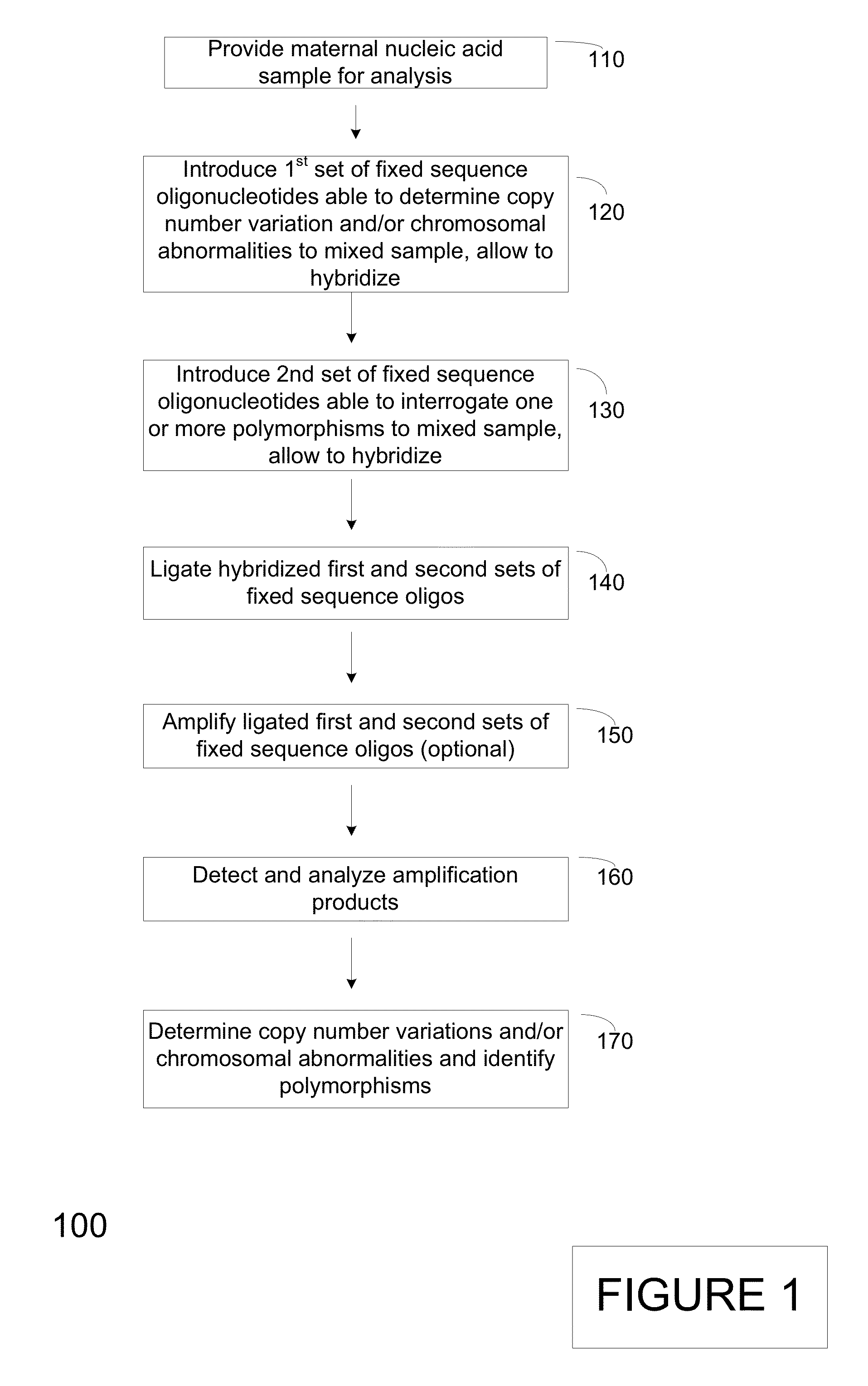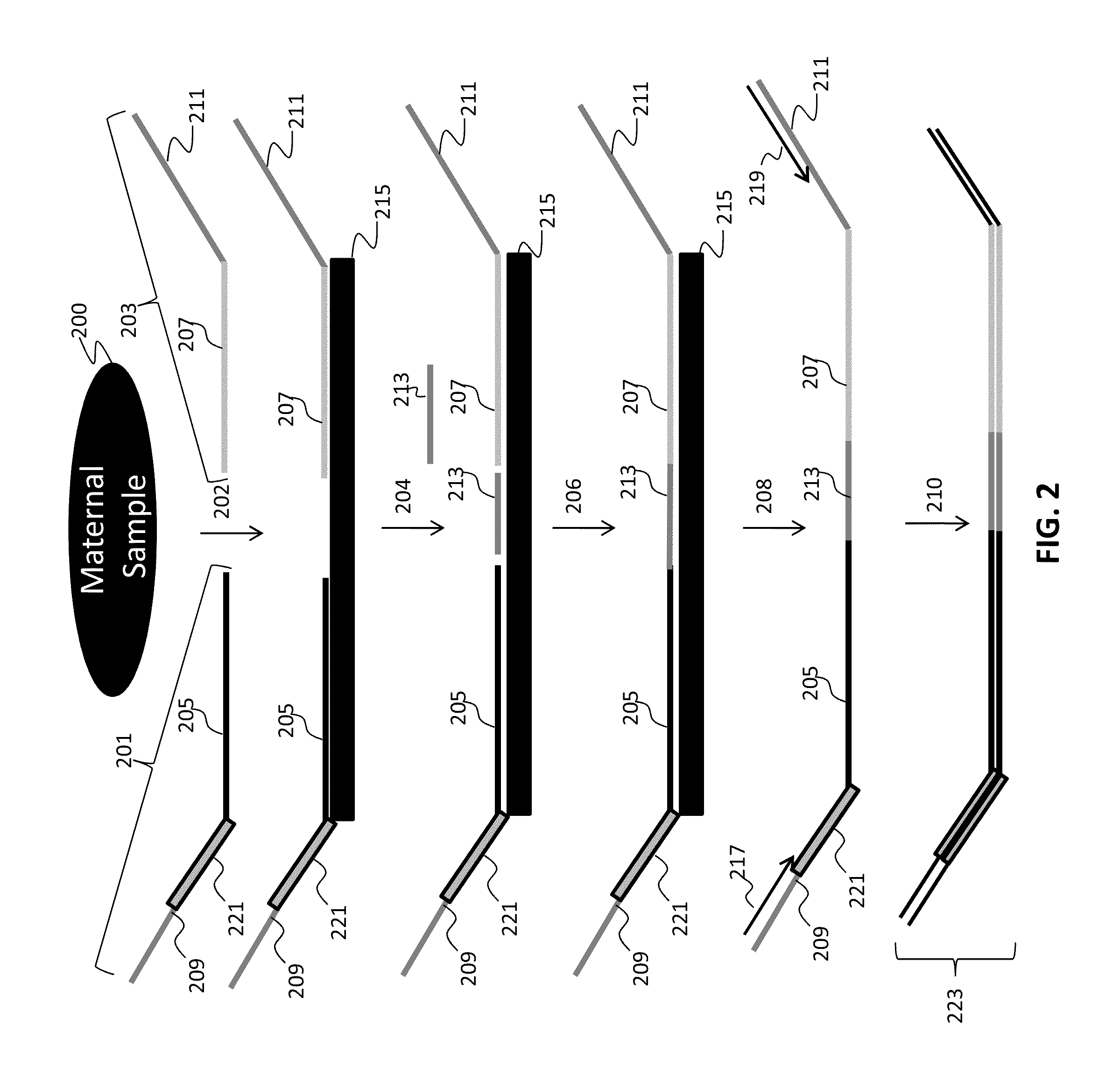Assay systems for genetic analysis
a technology of genetic analysis and assay system, which is applied in the field of detection and quantification of genetic abnormalities, can solve the problem of limited amplification before detection, and achieve the effect of reducing the number of false positives and false positives
- Summary
- Abstract
- Description
- Claims
- Application Information
AI Technical Summary
Benefits of technology
Problems solved by technology
Method used
Image
Examples
example 1
General Aspects of the Assay Systems of the Invention
[0272]A number of assay formats were tested to demonstrate the ability to perform selective amplification and detection of independent loci to demonstrate multiplexed, ligation-based detection of a large number (e.g., 96 or more) of loci of interest. These loci included loci that were indicative of the presence of a particular chromosome or the presence or absence of a mutation or polymorphism in a particular allele.
[0273]These assays were designed based on human genomic sequences, and each interrogation consisted of two fixed sequence oligos per selected locus interrogated in the assay. The first oligo, complementary to the 3′ region of a genomic region, comprised the following sequential (5′ to 3′) oligo elements: a universal PCR priming sequence common to all assays: TACACCGGCGTTATGCGTCGAGAC (SEQ ID NO:1); a nine nucleotide identification index specific to the selected locus; a 9 base locus- or locus / allele-specific sequence th...
example 2
Preparation of DNA for Use in Tandem Ligation Procedures
[0278]Genomic DNA from a Caucasian male (NA12801) or a Caucasian female (NA11995) was obtained from Coriell Cell Repositories (Camden, N.J.) and fragmented by acoustic shearing (Covaris, Woburn, Mass.) to a mean fragment size of approximately 200 bp.
[0279]The Coriell DNA was biotinylated using standard procedures. Briefly, the Covaris fragmented DNA was end-repaired by generating the following reaction in a 1.5 ml microtube: 5 μg DNA, 12 μl 10× T4 ligase buffer (Enzymatics, Beverly Mass.), 50 U T4 polynucleotide kinase (Enzymatics, Beverly Mass.), and H20 to 120 μl. This was incubated at 37° C. for 30 minutes. The DNA was diluted using 10 mM Tris 1 mM EDTA pH 8.5 to desired final concentration of ˜2 ng / μl.
[0280]5 μl DNA was placed in each well of a 96-well plate, and the plate sealed with an adhesive plate sealer and spun for 10 seconds at 250×g. The plate was then incubated at 95° C. for 3 minutes, cooled to 25° C., and spun a...
example 3
Exemplary Assay Formats Using Tandem Ligation
[0282]Numerous tandem ligation assay formats using the biotinylated DNA were tested to illustrate proof of concept for the assay systems of the invention, and demonstrated the ability to perform highly multiplexed, targeted detection of a large number of independent loci using the series of different assay formats. The exemplary assay systems of the invention were designed to comprise 96 or more interrogations per loci in a genetic sample, and in cases where SNPs were detected the assay formats utilized 192 or more separate interrogations, each utilizing the detection of different alleles per 96 loci in genetic samples. The examples described for each assay format utilized two different sets of fixed sequence oligonucleotides and / or bridging oligos (as described in Example 1), comprising a total 96 or 192 interrogation reactions for the selected loci depending upon whether or not SNPs were identified.
[0283]A first exemplary assay format u...
PUM
 Login to View More
Login to View More Abstract
Description
Claims
Application Information
 Login to View More
Login to View More - R&D
- Intellectual Property
- Life Sciences
- Materials
- Tech Scout
- Unparalleled Data Quality
- Higher Quality Content
- 60% Fewer Hallucinations
Browse by: Latest US Patents, China's latest patents, Technical Efficacy Thesaurus, Application Domain, Technology Topic, Popular Technical Reports.
© 2025 PatSnap. All rights reserved.Legal|Privacy policy|Modern Slavery Act Transparency Statement|Sitemap|About US| Contact US: help@patsnap.com



